
by Victoria Silverwolf
Yin and Yang

An ancient Chinese representation of the topic I will discuss.
Up and down. Left and right. Hot and cold. Female and male. Good and evil.
There's a natural tendency for human beings to think in pairs of contrasting concepts, sometimes in opposition, sometimes complementing each other. Such dualities are useful, but are often greatly oversimplified, painting everything as black or white, and ignoring the many shades of gray between.
I thought about this, oddly enough, when I heard the news just yesterday that Singapore is no longer part of the nation of Malaysia, as it had been since winning full independence from the United Kingdom in 1963. Instead, it is now a sovereign nation.

Lee Kuan Yew, Prime Minister of Singapore, announces the city-state's new status at a press conference.
Political differences between the central Malaysian government and Singapore led to the split, as well as strife between persons of Malay ethnicity and the mostly ethic Chinese population of Singapore. It's not yet clear whether Malaysia kicked Singapore out, or if the city left of its own free will.
This division of one nation into two made me think about the way our minds see things as dyads. I even perceived recent hit songs as a pair of opposites.
For most of July, (I Can't Get No) Satisfaction by the Rolling Stones was at the top of the American music charts. It's a hard-driving tune, sure to grab your attention the first time you hear it.

And it's now my favorite rock 'n' roll song.
As if the gods of record stores and jukeboxes wanted to help me prove my theory of duality, the song that reached Number One in the USA this month could not be more different. Herman's Hermits have a smash on their hands with I'm Henry VIII, I Am, a comic music hall ditty that goes all the way back to 1910.

The success of this very silly song may foretell the end of the world.
New and old. Serious and funny. Good and bad. (OK, that last one is a matter of opinion.) Even when it comes to entertainment, things seem to exist as opposites, at least in our heads. The latest issue of Fantastic is no exception.
It's Two — Two — Two Magazines In One!
I trust the makers of Certs will forgive me for making fun of the well-known slogan from their TV commercials. It's appropriate for the revised version of Fantastic, which combines one new story with a quartet of reprints.
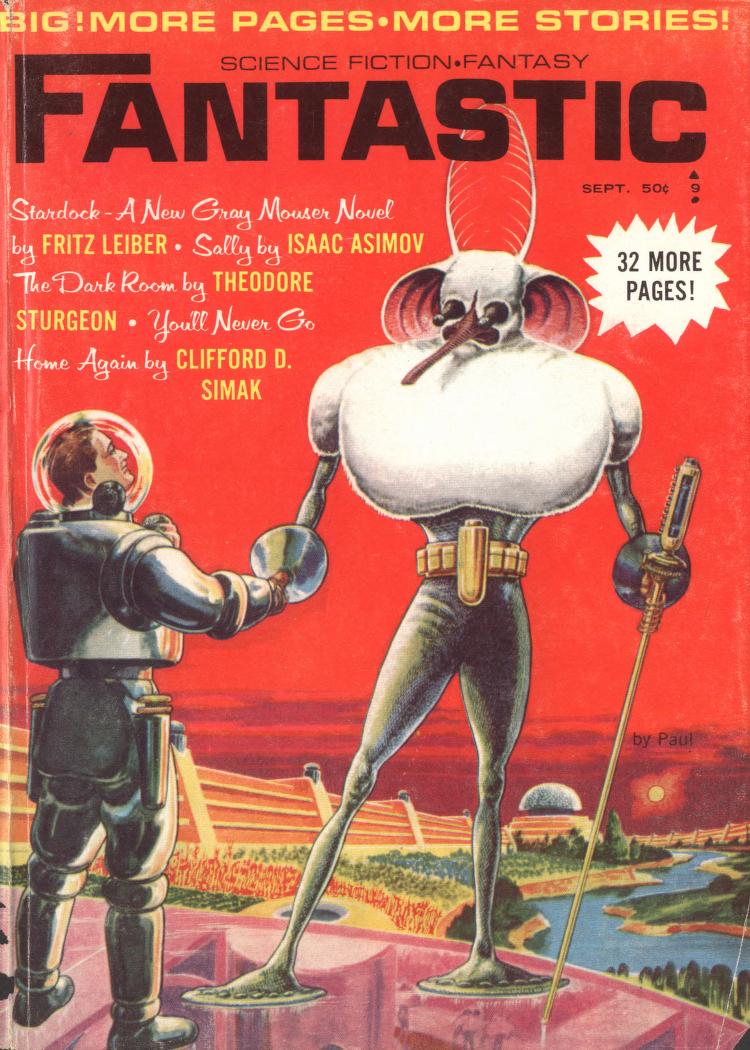
Art by the late Frank R. Paul.
That cover looks pretty old-fashioned, doesn't it? That's because it first appeared more than a quarter of a century ago, as the back cover of the very first issue of Fantastic Adventures, May 1939.
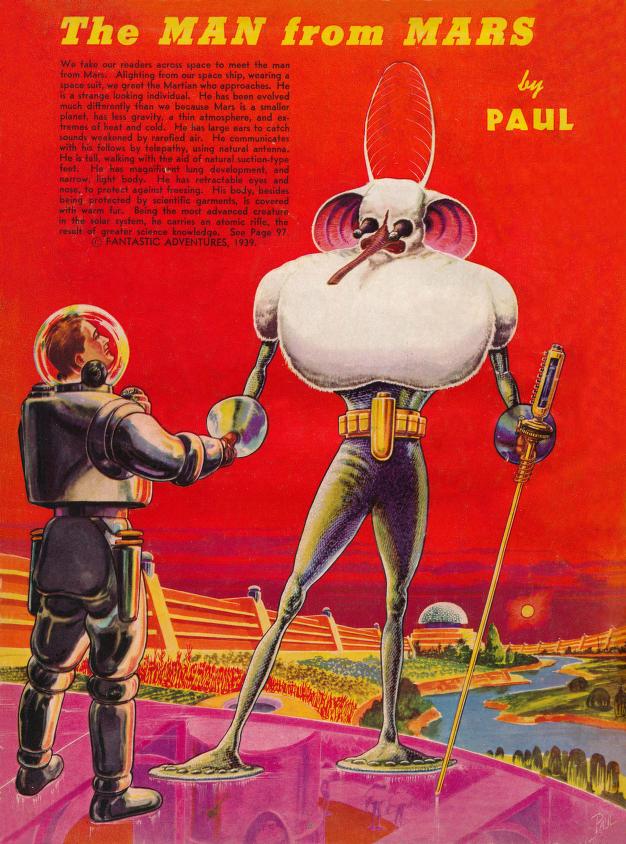
Look familiar?
The new publisher of Fantastic obviously intends to reuse as much material from the past as possible. Also dating back to the innocent days before World War Two is the following now-dated scientific explanation for why a Martian might look something like the being on the right. (The one on the left is a human, in case you were wondering.)
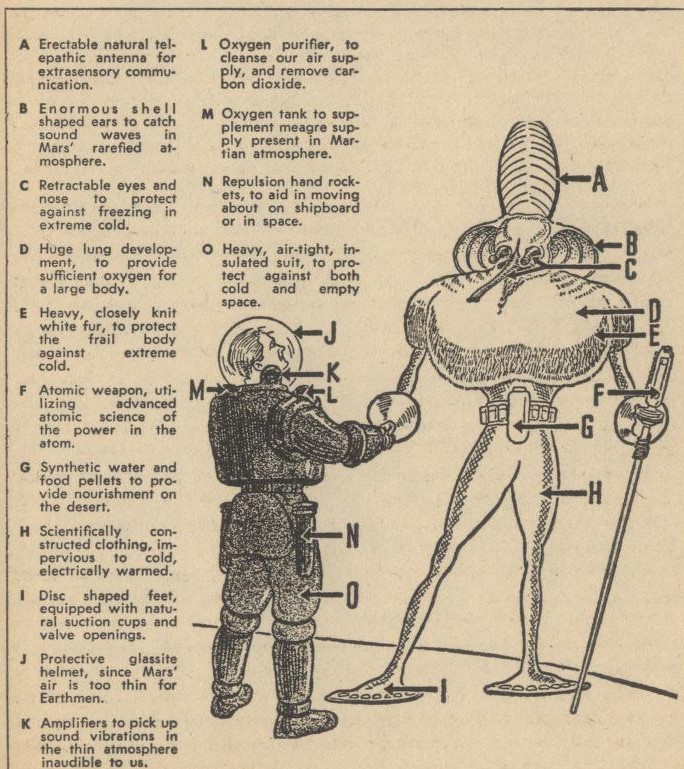
The redundancy in Item F makes me giggle.
Before this place becomes, as Tom Lehrer put it in Bright College Days, soggy with nostalgia, let's take a look at something hot off the presses.
Starting off the issue is a new adventure of Fafhrd and the Gray Mouser, whom we've met many times before.
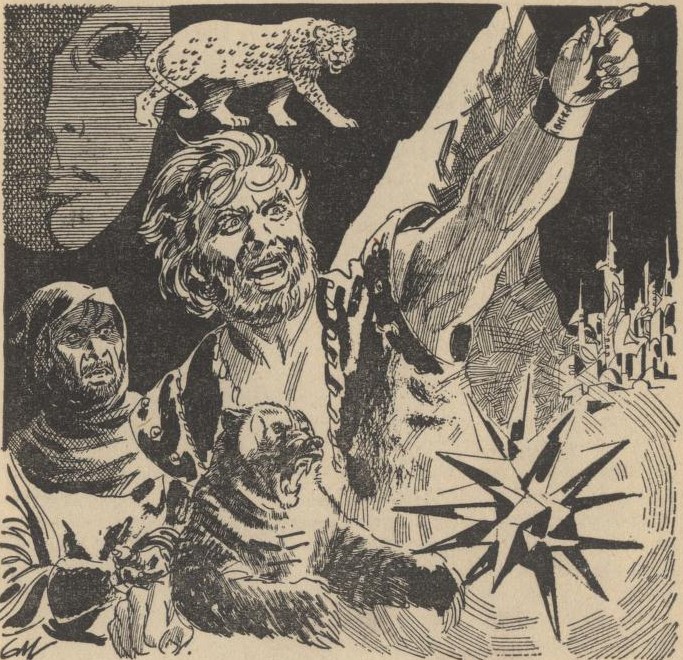
Illustrations by Gray Morrow. You can already tell that a lot is going to happen.
This time we're in Fafhrd's homeland, a place of snow and ice. A cryptic bit of doggerel leads our heroes to a chain of mountains. In search of a fabulous treasure, the ill-matched pair make their way, slowly and painfully, up a gigantic peak. Along for the fun is a large white feline, who becomes as important a member of the team as the giant Northerner and the diminutive Southerner.
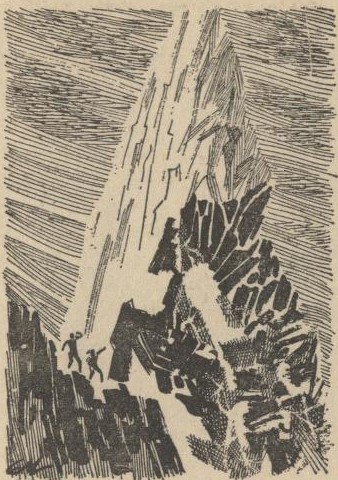
They've already made a long, hard climb before they even begin to scale the highest mountain.
All kinds of challenges and mysteries stand in their way. The Gray Mouser has visions of a green, mask-like face, and Fafhrd experiences dreams of touching a woman he can't see. Two rivals are after the same treasure, and they have a pair of unusual companions. Most bizarre of all, gigantic invisible beasts, something like flying mantas, carry equally unseen enemies.
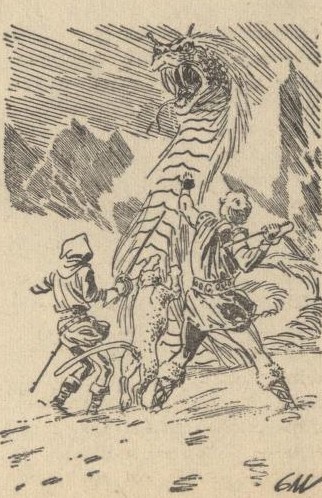
And what would a sword-and-sorcery yarn be without a monster to fight?
Eventually, the bold duo reach the top of the mountain, encounter the beings who live inside, and find out who led them there, and why.
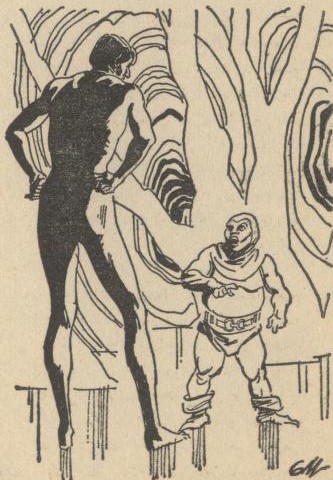
A naked Gray Mouser and a dwarf who isn't naked.
Lieber's imagination runs wild here, and his writing is simply gorgeous. A lecture by Fafhrd, in which he describes each mountain in poetic language, is a thing of beauty. The trek up the ice-covered peak is described in exquisite, vivid detail. (I suggest reading this story while wrapped in a blanket and sipping hot cocoa.) There are enough fantasy elements for a full-length novel, and the plot has plenty of twists and turns to keep the reader's attention.
Five stars.
The rest of the magazine consists entirely of reprints. The first comes from the pen of the Good Doctor. It first appeared in the May/June 1953 issue of the same publication.

Art by W. T. Mars. At least Ike got his name on the cover.
As you might expect, the story deals with robots, of a sort. In this case, we're talking about self-driving automobiles, with positronic motors that are also their brains. The narrator runs a sort of retirement home for these intelligent vehicles, once their owners have passed on. The cars have personalities, as far as their caretaker is concerned. The sedans are boys, and the convertibles are girls, including the title character.
An unscrupulous fellow, one of Asimov's few villains, tries to purchase the retired cars, so he can put their brains into different bodies. The idea is that he can then make a profit, selling old autos for new. The narrator, as horrified as he would be if the man was suggesting vivisection on people, refuses. The Bad Guy returns, using force this time to get his way. Let's just say that things don't work out for him.
There aren't a lot of surprises in the plot, unless you count the fact that the author's famous Three Laws of Robotics don't apply here. As usual for Doctor A, he writes clearly and efficiently.
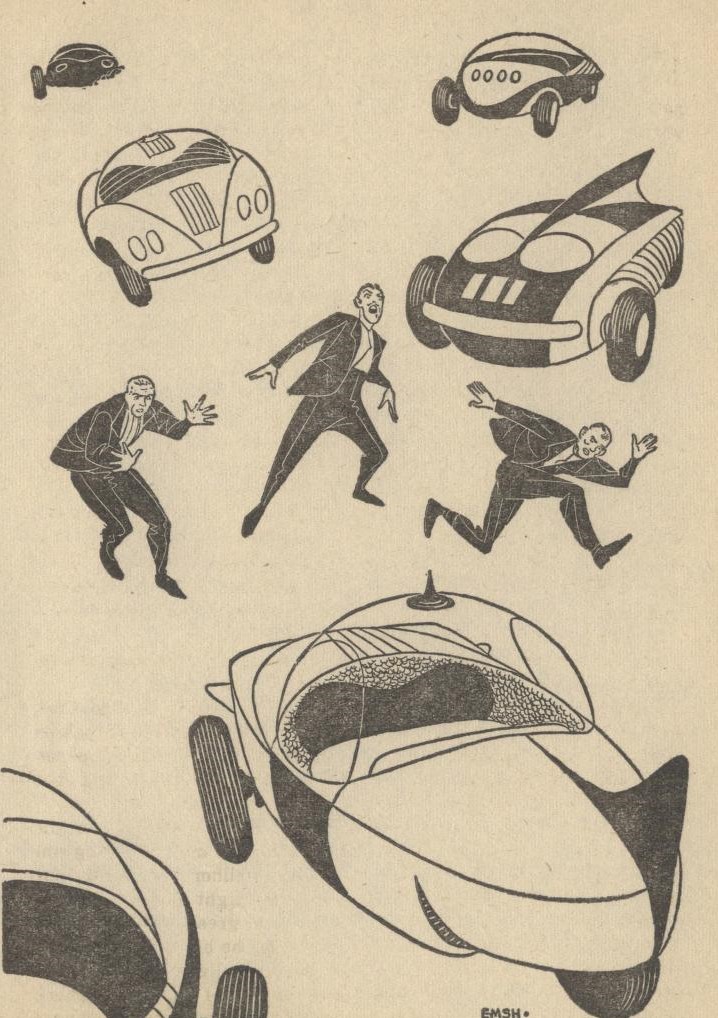
Illustration by Emsh. All the illustrations for previously published stories are also reprints.
Automobile enthusiasts, among whom I cannot count myself, will probably get an extra kick out of this story. I thought it was worth reading, while waiting to have your vehicle fixed at the car shop.
Three stars.
"You'll Never Go Home Again", by Clifford D. Simak
This story first appeared in the July 1951 issue of Fantastic Adventures (not to be confused with Fantastic.) Flipping through the pages of the older magazine, I note that it still had the quotation marks around the title, but also had an exclamation point. (I worry about these things.)

Art by Robert Gibson Jones. The cover story has an exclamation mark also, as do several other pieces in the table of contents. I guess it was an exciting magazine.
A team of space explorers lands on a distant planet. It's made very clear, right from the start, that these folks are extremely careful when it comes to investigating a new world. The many scientists aboard the spaceship check out everything to make sure the place is safe, and there are soldiers to keep the peace.
A seemingly primitive humanoid alien shows up. A gizmo allows the alien and the humans to communicate, which is definitely a convenient plot device. The extraterrestrial offers the statement quoted in the title (without exclamation mark) not as a threat, but simply as a statement of fact.
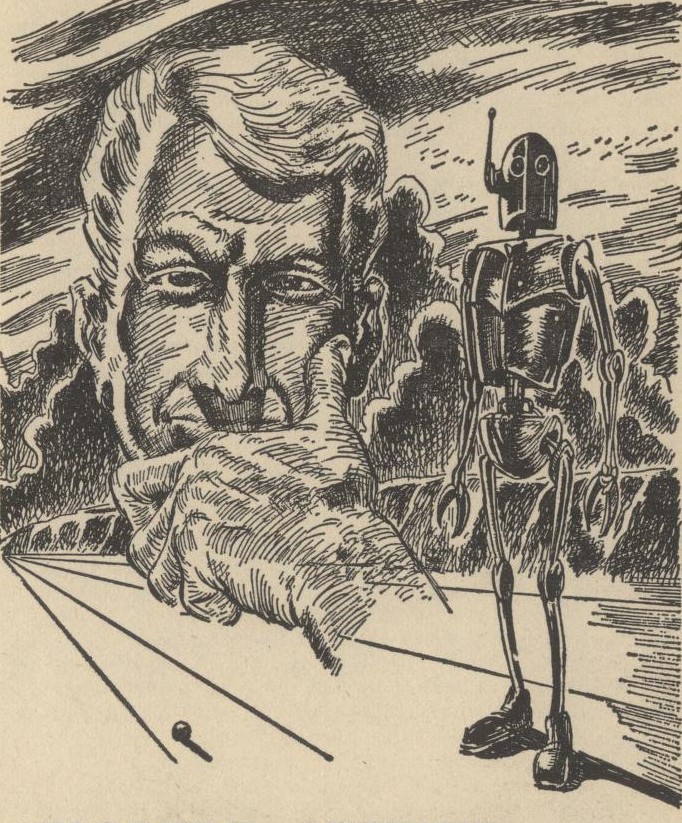
Illustrations by Leo Summers.
The rest of the story deals with the explorers trying to figure out what the alien meant. It turns out to be something about the planet they hadn't considered.
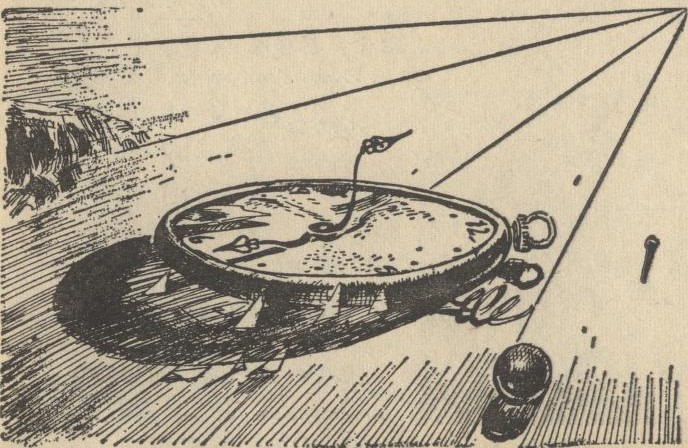
A broken watch provides a clue.
In essence, this is an Astounding-style puzzle story, and not a very interesting example of one. Somebody like Hal Clement would have come up with a better solution to the mystery. By 1951, Simak was already an experienced pro, so it's written decently. However, there is none of the appreciation for the outdoors, or the affection for all living things, that we expect from him.
Two stars.
The Dark Room, by Theodore Sturgeon
We go back to Fantastic (not to be confused with Fantastic Adventures, or, for that matter, Fantastic Universe) and dig out a copy of the July-August 1953 issue for our next blast from the past.

Art by Rupert Conrad. The great Theodore Sturgeon is reduced to being one of others.
We begin with a married couple leaving a party. They're both devastated by what has just happened. You have to read between the lines a bit, but it becomes clear that the woman, for no reason she can explain, had sex with another man there.

Illustrations by Emsh.
After the couple breaks up, the man, still an emotional wreck, finds out that other people have done equally inexplicable things at parties held by the same wealthy host.
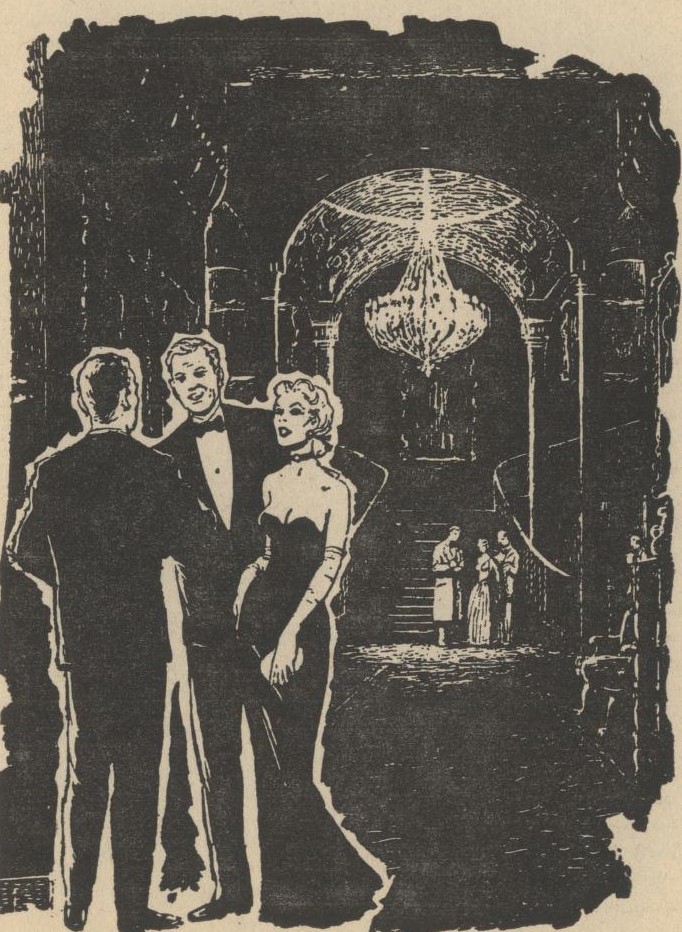
Looks like a nice party, doesn't it?
Some of these incidents are minor, as when a sweet, grandmotherly woman who writes innocent books for children comes up with an extremely dirty story. Some seem good, as when a man who knows nothing at all about music creates a hit song. Others are much more serious, even including murder. In each case, somebody did something completely out of character.
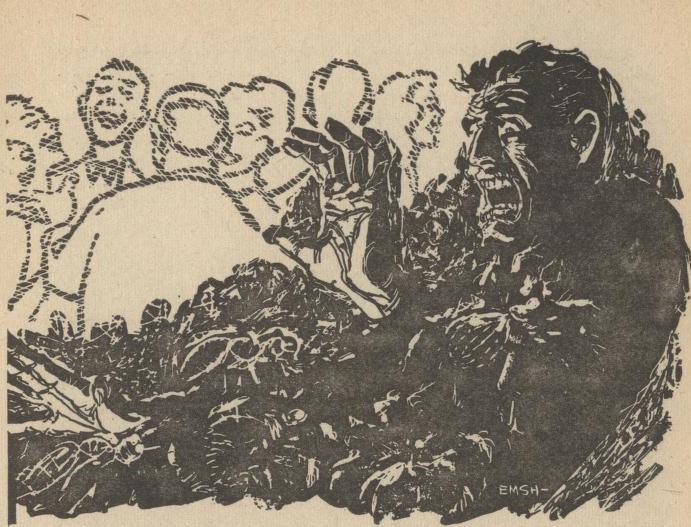
Maybe not so nice after all.
Launching his own investigation into the mystery, the betrayed husband sneaks into the rich man's home; in particular, to the dark room of the title. (This is itself an anomaly, as the room is decorated in an ultra-modern fashion, while the rest of the house is very conservative.) He discovers something strange and frightening, and learns an uncomfortable fact about himself.
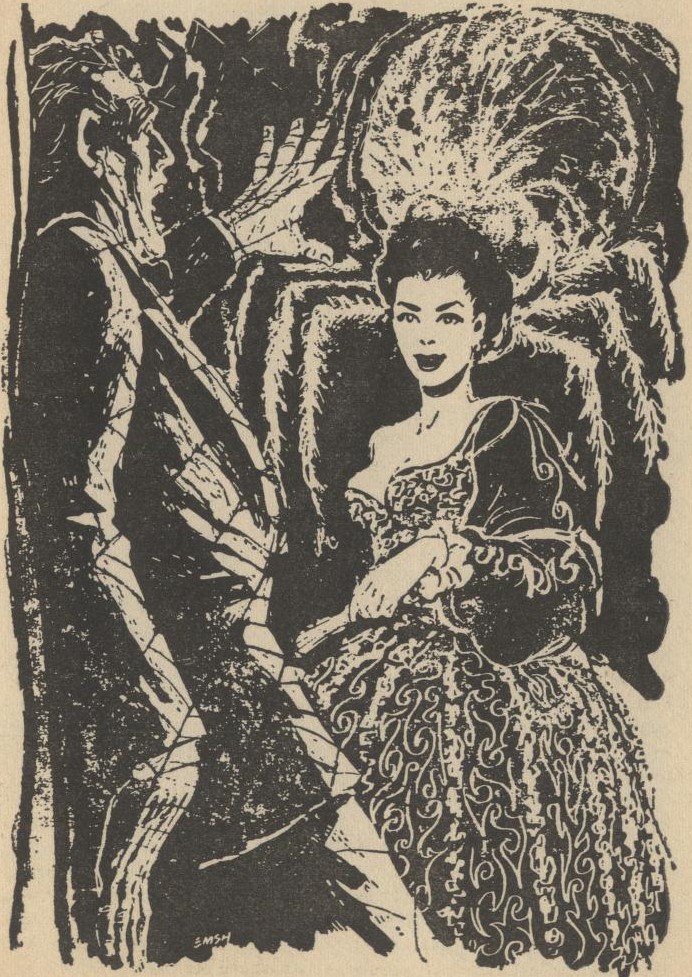
The lady and the spider have more in common than first meets the eye.
This unique psychological fantasy, with more than a touch of horror, demonstrates Sturgeon's gift for creating memorable, three-dimensional characters. The premise is much more subtle than just the typical monster story you might expect when the giant spider shows up. It might even make you ponder your own personality, and what you would never do.
Four stars.
The Worm, by David H. Keller, M. D.
As Mister Peabody might have said to Sherman, it's time to jump into the WayBack machine, and visit the remote past. Come with me now to the year 1929, and the March issue of Amazing Stories.
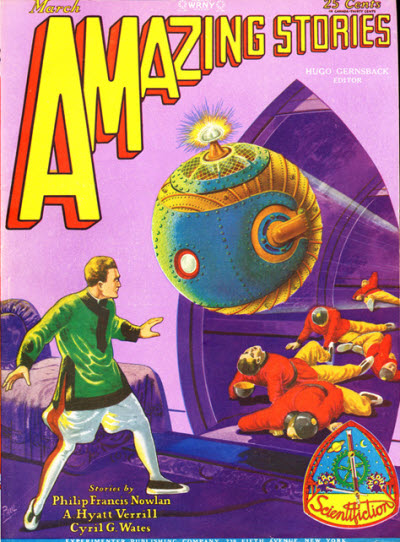
Art by Frank R. Paul, of course.
An old guy lives alone, except for his dog, in a mill that hasn't been used in a long time. He hears an odd noise, similar to what the mill's grinding stones used to sound like, coming from beneath the basement. Pretty soon the source of the noise is obvious.
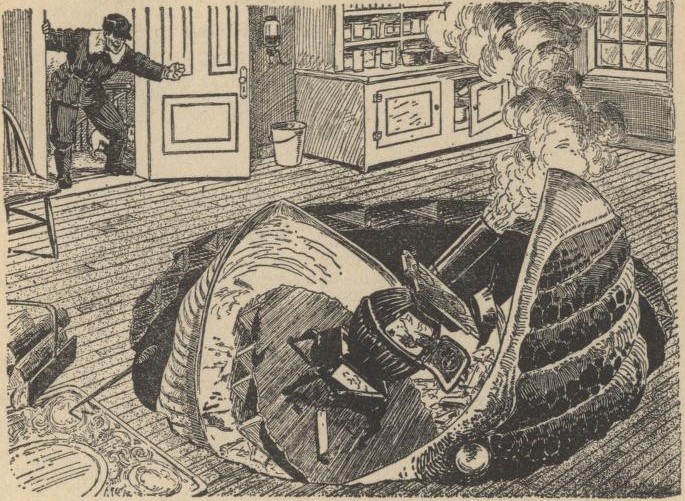
Illustration by Frank R. Paul, naturally.
The man makes a desperate effort to stop the bizarre creature from destroying his home and everything in it. Does he succeed? You'll have to read the story to find out.
I have to admit that I wasn't expecting much from a Gernsbackian, pre-Campbellian, bit of scientifiction from three-and-one-half decades ago. To my surprise, this chiller was pretty well written. There's even some sophisticated characterization, as when the man recites random bits of poetry to himself. It's a simple yarn, executed with some talent.
Three stars.
Half a Loaf is Better Than None
With extra pages, and the contrast between original fiction and reprints, I felt like I was getting two magazines for the price of one. The first part, with Leiber's fine new story, was worth four bits all by itself. The second part was a mixed bag. Sturgeon's story was very good, Simak's was a disappointment, and the others were OK, if nothing special. If you pick up a copy, I'd suggest taking a break and enjoying a cup of coffee after you read Stardock, so you'll be ready for some lesser works.

It would seem fitting to add some of this stuff to your java.
[Come join us at Portal 55, Galactic Journey's real-time lounge! Talk about your favorite SFF, chat with the Traveler and co., relax, sit a spell…]

![[August 10, 1965] Binary Arithmetic (September 1965 <i>Fantastic</i>)](https://galacticjourney.org/wp-content/uploads/2020/07/Fantastic_v15n01_1965-09_0000-2-672x372.jpg)
